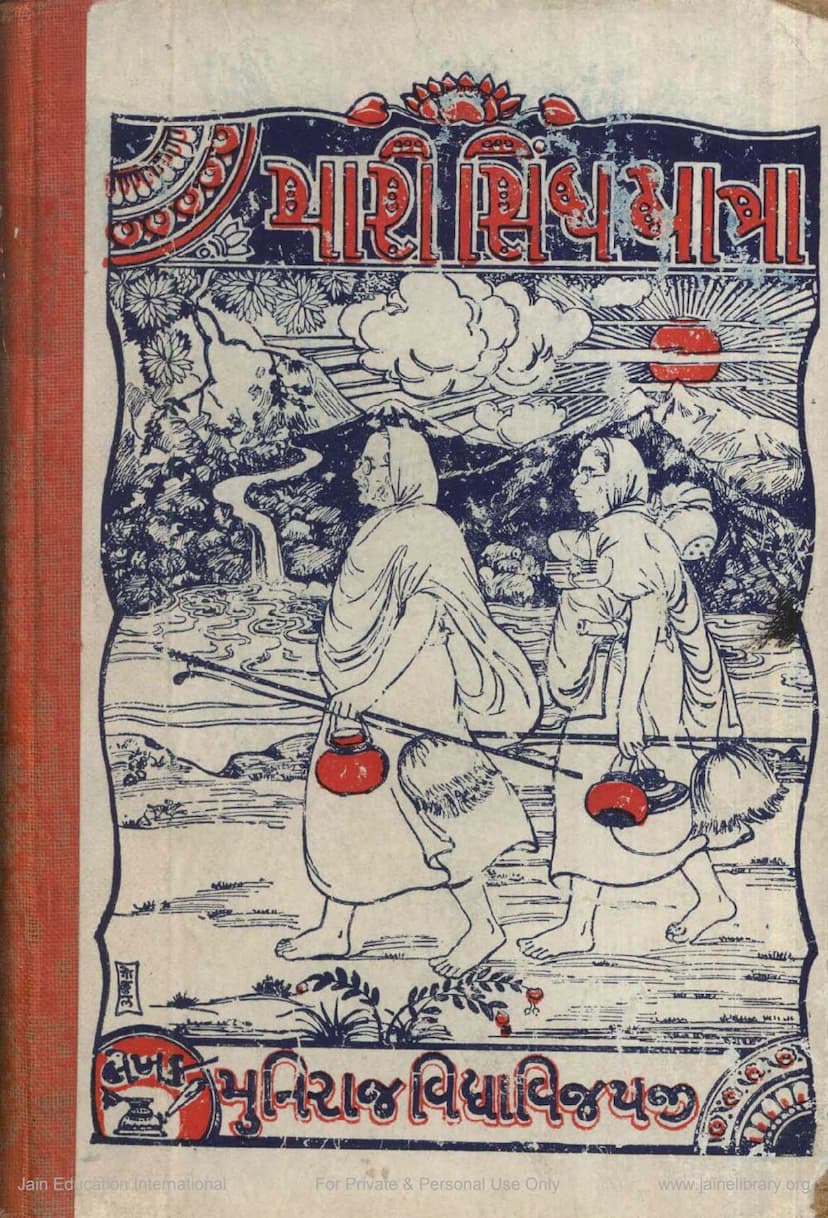Mari Sindh Yatra
Added to library: September 2, 2025

Summary
Certainly! Here's a comprehensive summary of the Jain text "Mari Sindh Yatra" by Vidyavijay, based on the provided Gujarati text:
Book Title: Mari Sindh Yatra (My Journey to Sindh) Author: Muni Shri Vidyavijayji Publisher: Shri Vijaydharmsuri Jain Granthamala, Ujjain Edition: Second Edition, published 1943 Value: ₹2-7-7 (likely Indian Rupees at the time)
Summary:
"Mari Sindh Yatra" is a travelogue written by the respected Jain monk Muni Shri Vidyavijayji, detailing his spiritual and physical journey through the region of Sindh. The book chronicles his experiences, observations, and the social, religious, and historical insights he gained during his travels.
Key Themes and Content:
-
The Author's Journey and Motivation: The book's genesis is attributed to the author's illness, which led to a period of seclusion and introspection. During this time, he was inspired to document his journey and the rich history and culture of Sindh. He emphasizes that his journey was not for personal gain but for the welfare of humanity and the propagation of Lord Mahavir's message of non-violence.
-
Historical and Geographical Context of Sindh: The initial chapters provide a detailed overview of Sindh's history and geography. It describes the region's ancient past, its rulers through various dynasties (including Arab, Rajput, Mughal, and British influences), and its geographical boundaries. The author highlights Sindh's significance in ancient India, mentioning its connection to the Indus Valley Civilization (Mohenjo-daro).
-
Jain Presence in Sindh: A significant portion of the book is dedicated to exploring the historical presence of Jainism in Sindh. Muni Vidyavijayji meticulously recounts the existence of ancient Jain temples, the monastic traditions (vihar) of Jain monks in the region, and the stories associated with prominent Jain sites like Godi Parshvanath and Umargadh. He notes the decline of Jain influence over centuries due to socio-political changes.
-
The Journey's Hardships and Devotion: The narrative vividly describes the arduous nature of the journey, especially the challenges faced by Jain monks who travel on foot, eschewing modern conveniences. The author details the difficulties of traversing sandy deserts, enduring harsh climates, and the scarcity of water. Despite these hardships, he emphasizes the unwavering faith and determination of the monks and the generous support they received from the Jain community.
-
Social and Cultural Observations: Muni Vidyavijayji keenly observes the social fabric of Sindh. He describes the demographic composition, with a significant Muslim majority and a Hindu minority whose customs often show Islamic influences. He discusses the distinct communities within the Hindu population, such as the 'Aamil' and 'Bhaiband' communities, detailing their professions, lifestyles, and inter-community relations. He also touches upon the prevailing 'leti-deti' (dowry) system and its negative impact, particularly on unmarried women.
-
Interactions and Activities in Karachi: A substantial part of the book is dedicated to the author's stay and activities in Karachi. He details his interactions with various religious and social leaders, including notable Jain community figures, as well as prominent individuals from other communities like Parsis and Sindhis. He highlights the organizational efforts of the Jain community in Karachi, mentioning the establishment of schools, libraries, and charitable institutions. The author also notes the significant contributions of the Gujarati diaspora in building Karachi's commercial and social landscape.
-
Emphasis on Ahimsa (Non-violence): Throughout the travelogue, Muni Vidyavijayji underscores the Jain principle of Ahimsa. He makes consistent efforts to promote vegetarianism and discourage animal sacrifice, particularly during festivals like Navratri and Dussehra. His interactions with meat-eating communities, including Muslims, often involved discussions about adopting a more compassionate diet.
-
Personal Reflections and Spiritual Insights: The book is interspersed with the author's personal reflections on life, spirituality, and the human condition. He shares anecdotes that illustrate the importance of faith, perseverance, and the pursuit of spiritual knowledge. The narrative reflects his profound spiritual outlook, even amidst physical ailments and challenging circumstances.
-
Community Support and Appreciation: The author expresses deep gratitude for the overwhelming support, hospitality, and respect he received from the Jain community in Karachi and other parts of Sindh. He highlights the generosity of individuals and community organizations that facilitated his journey and activities, making his mission a success. The heartfelt appreciation from the community is evident in the honorifics and commendations bestowed upon him.
-
Interfaith Harmony: The author's interactions with various religious communities, including Muslims and Parsis, and his participation in interfaith gatherings like the 'Sarva Dharma Parishad' and 'Sarva Hindu Dharma Parishad,' showcase his commitment to promoting religious harmony and understanding. His ability to connect with people from diverse backgrounds and inspire positive change is a recurring theme.
Structure and Style:
The book is structured chronologically, following the author's journey. The language is Gujarati, and the style is narrative and reflective, often incorporating dialogues and personal anecdotes. The author's profound knowledge of Jain scriptures, history, and his insightful social commentary make the book both informative and inspiring.
Overall Significance:
"Mari Sindh Yatra" is a valuable document that not only chronicles a significant pilgrimage but also provides a historical, social, and spiritual record of Jain life and traditions in Sindh during that era. It serves as a testament to the author's dedication to his spiritual path and his commitment to societal welfare. The book also highlights the resilience of faith and the power of compassion in a diverse cultural milieu.